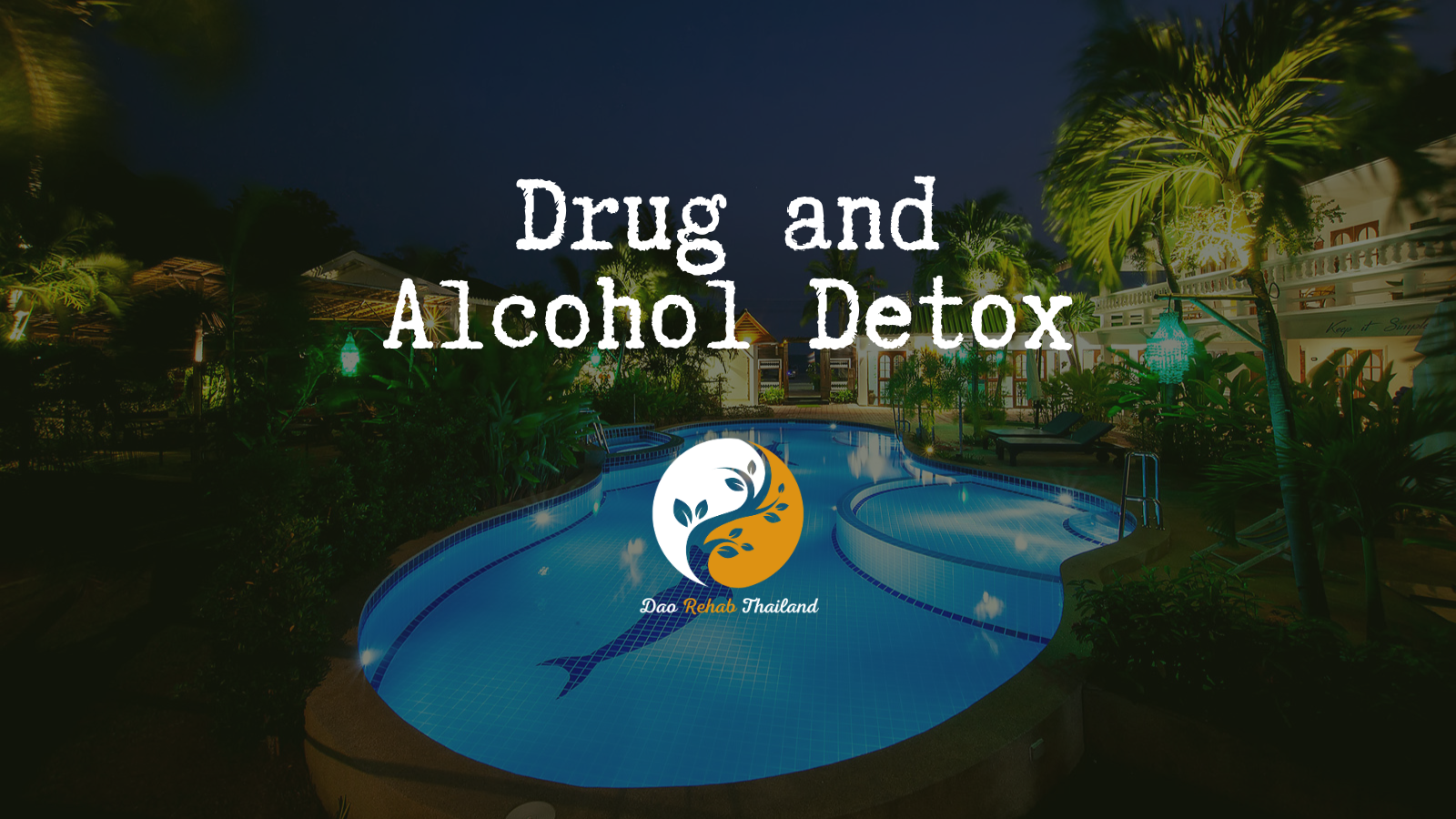
Drug and Alcohol Detox – Treatment in Thailand
Drug and Alcohol Detox
“Turning the impossible into possible”

"Detox from Drug and Alcohol at a Luxury Holistic Center in Thailand and Israel"

Drug and Alcohol Detox
Drug and alcohol detox is the process of clearing the body of substances and managing withdrawal symptoms that arise when someone stops using drugs or alcohol after prolonged use. Detox is often the first step in addiction treatment, preparing individuals physically and mentally for further recovery.
"Holistic Center for Trauma, Addiction, and Mental Imbalance Treatment in Thailand"
“Come to the beginning of the journey to freedom from addiction to alcohol, drugs, and pills, and rediscover your life within the quiet embrace of DaoTherapy Rehab in Thailand—where holistic healing meets empowering recovery.”
DaoTherapy Holistic Rehab
Key Elements of Drug and alcohol Detox:
Medical Supervision: Drug and alcohol detox must be conducted under medical supervision, as the body may experience withdrawal symptoms. These can include nausea, anxiety, muscle aches, and insomnia. A medical team will monitor and manage these symptoms to ensure the patient’s safety and comfort.
Holistic Therapies:
Holistic Therapies: Many detox programs incorporate holistic therapies such as mindfulness, yoga, and meditation to help individuals cope with stress and anxiety during the detox process. These therapies support the mind-body connection and contribute to overall recovery.
Tapering Process
Tapering Process: Drug and alcohol detox often involves a gradual tapering of the drug to reduce withdrawal severity. Doctors will slowly decrease the dosage over time to allow the body to adjust to lower levels of the substance.
Psychological Support:
Psychological Support: Like any addiction recovery process, detox from Drug and alcohol includes psychological support. This can involve counseling, therapy, or support groups to address the mental and emotional aspects of addiction.
Post-Detox Treatment:
Post-Detox Treatment: After completing detox, continuing treatment is crucial to prevent relapse. This often includes participation in ongoing therapy, group support, and the development of new coping strategies to maintain sobriety.
Drug and alcohol
Drug and alcohol detox is the process of clearing the body of substances and managing withdrawal symptoms that arise when someone stops using drugs or alcohol after prolonged use. Detox is often the first step in addiction treatment, preparing individuals physically and mentally for further recovery.
What Is Detox?
Detoxification (detox) helps remove substances from the body while monitoring and managing withdrawal symptoms. This process aims to stabilize individuals and support them as their bodies adjust to functioning without the substance.
Types of Detox Programs
1. Medical Detox – Conducted in a hospital or detox center, medical detox involves constant medical supervision, often with medications to ease symptoms. This is recommended for those with severe dependence or those at risk of dangerous withdrawal symptoms.
2. Inpatient Detox – Similar to medical detox, but may be in a residential facility where individuals receive structured support around the clock. This option provides a controlled environment, reducing access to substances.
3. Outpatient Detox – For those with mild to moderate dependence, outpatient detox allows individuals to receive treatment while living at home, attending regular check-ups, and managing withdrawal symptoms with support.
Withdrawal Symptoms and Risks
Withdrawal symptoms vary depending on the substance, duration of use, and individual factors. Symptoms can include:
– Physical: Nausea, sweating, tremors, muscle pain, and seizures.
– Psychological: Anxiety, depression, mood swings, irritability, and intense cravings.
Some substances, such as alcohol and benzodiazepines, can have severe withdrawal symptoms, including seizures or delirium tremens (DTs), making medical detox essential for safety.
Medications Used in Detox
Medications are sometimes used to ease withdrawal symptoms, reduce cravings, and prevent relapse. Common medications include:
– Alcohol: Benzodiazepines for anxiety and seizures; naltrexone or acamprosate to reduce cravings.
– Opioids: Methadone or buprenorphine to manage cravings and reduce withdrawal symptoms.
– Benzodiazepines: Tapering under medical supervision to avoid seizures.
Steps in the Detox Process
1. Assessment – Medical professionals evaluate the individual’s physical and mental health, addiction history, and any underlying conditions to create a personalized detox plan.
2. Stabilization – The detox team monitors withdrawal symptoms, using medications if necessary, and provides physical and emotional support.
3. Preparation for Treatment – Detox alone is not a cure for addiction. Once stabilized, individuals are encouraged to enter a treatment program that includes counseling, therapy, and support groups to address the psychological aspects of addiction.
Post-Detox and Long-Term Recovery
Detox is the beginning of recovery, but long-term treatment is needed to address the root causes of addiction. After detox, individuals often enter a rehabilitation program, which can be inpatient or outpatient, to work on relapse prevention, coping strategies, and personal growth.
The Importance of Support During Detox
Professional supervision, along with emotional support from friends, family, or recovery groups, is essential during detox. Support helps individuals manage cravings and emotional challenges, providing motivation to continue their recovery journey.
Conclusion
Drug and alcohol detox is a critical first step toward sobriety and recovery. While detox removes substances from the body, addressing the psychological aspects of addiction requires ongoing treatment and support. A structured detox plan, followed by a comprehensive treatment program, can help individuals build a solid foundation for long-term recovery.

contact us
Contact us with your questions
We would love to speak with you! Feel free to reach out with any questions.

get in touch
Schedule a free consultation
Schedule a free consultation with our team and let’s make things happen!
What is alcohol withdrawal syndrome?
Alcohol Withdrawal Syndrome (AWS) is a collection of symptoms that occur when a person with alcohol dependence suddenly stops or significantly reduces alcohol consumption. AWS can vary in severity, from mild symptoms to life-threatening complications, depending on the extent of alcohol dependence, the duration of drinking, and individual health factors.
Symptoms of Alcohol Withdrawal Syndrome
Symptoms typically start within 6–24 hours after the last drink and can last several days to a week or more. AWS progresses through stages of increasing severity:
1. Mild Symptoms (6–12 hours after last drink)
– Anxiety, irritability, and mood swings
– Headaches
– Sweating
– Nausea and vomiting
– Tremors or shaking (especially in the hands)
– Difficulty sleeping
2. Moderate Symptoms (12–48 hours after last drink)
– Increased heart rate and high blood pressure
– Confusion and restlessness
– Hallucinations (visual, auditory, or tactile)
– Severe anxiety and panic attacks
– Sweating and tremors
3. Severe Symptoms (Delirium Tremens, or DTs) (48–72 hours after last drink)
– Extreme agitation and confusion
– Fever and dehydration
– Hallucinations (often frightening or vivid)
– Seizures
– Rapid heart rate, high blood pressure
– Delirium tremens (DTs) can be life-threatening without medical intervention.
Causes of Alcohol Withdrawal Syndrome
AWS occurs because the brain and body have adapted to the constant presence of alcohol. Alcohol acts as a depressant on the central nervous system, slowing down brain activity and altering neurotransmitter balance. Over time, the brain adapts by increasing excitatory neurotransmitters to balance the depressive effects. When alcohol is suddenly removed, the brain becomes hyperactive, resulting in withdrawal symptoms.
Risk Factors for Severe Withdrawal
– High Levels of Alcohol Consumption: The more someone drinks over a prolonged period, the higher the risk.
– Previous Withdrawal Experiences: Individuals who have previously experienced AWS may face more severe symptoms in future episodes.
– Co-occurring Health Issues: Other medical or mental health conditions can worsen withdrawal symptoms.
Treatment of Alcohol Withdrawal Syndrome
AWS requires medical supervision, especially for moderate to severe cases. Treatment may include:
1. Medical Detoxification: In a detox setting, medical staff monitor symptoms and provide care.
2. Medications: Benzodiazepines (like diazepam or lorazepam) are commonly used to manage symptoms and prevent seizures. Antipsychotic medications may help with hallucinations.
3. Hydration and Nutrition: Supportive care includes rehydration, nutrition, and vitamins (especially thiamine) to prevent complications like Wernicke-Korsakoff syndrome.
4. Psychological Support: Managing anxiety and providing reassurance are essential to help individuals cope with symptoms.
Importance of Professional Supervision
For individuals with severe alcohol dependence, stopping alcohol suddenly without medical support can be dangerous and even fatal. Medical detox allows for safe symptom management, monitoring, and the use of medications to ease withdrawal.
Post-AWS Recovery
Once stabilized, individuals are encouraged to enter a treatment program, such as counseling, therapy, or support groups, to address the underlying causes of alcohol dependence and build coping strategies for long-term recovery.
Conclusion
Alcohol Withdrawal Syndrome is a serious condition with potentially life-threatening symptoms, but with proper medical care and support, individuals can safely manage withdrawal and begin their journey toward recovery.
What is delirium tremens?
Delirium tremens (DTs) is a severe and potentially life-threatening form of alcohol withdrawal that typically occurs in people with a history of heavy, long-term alcohol use. DTs involve sudden and intense changes in mental and nervous system functioning and usually occur within 48–72 hours after the last drink, although symptoms can sometimes appear up to 10 days later.
Symptoms of Delirium Tremens
DTs are characterized by both physical and psychological symptoms that include:
1. Severe Confusion and Disorientation – Individuals may not know where they are or what is happening, with extreme difficulty concentrating.
2. Agitation and Restlessness – Intense anxiety and agitation are common, often accompanied by uncontrollable tremors.
3. Hallucinations – Vivid and frightening visual, auditory, or tactile hallucinations can occur, making individuals perceive things that aren’t there.
4. Seizures – DTs increase the risk of seizures, which can be life-threatening and require immediate medical intervention.
5. High Fever and Excessive Sweating – Body temperature and heart rate can spike, leading to dehydration and electrolyte imbalances.
6. **Rapid Heart Rate and High Blood Pressure** – Cardiovascular symptoms may be severe and increase the risk of complications.
Causes of Delirium Tremens
DTs result from the brain’s adaptation to the depressant effects of alcohol. Alcohol suppresses the central nervous system, and chronic use leads the brain to counterbalance this by increasing excitatory neurotransmitter activity. When alcohol is abruptly stopped, the brain becomes hyperactive, leading to the intense symptoms of DTs.
Risk Factors for DTs
Certain factors increase the likelihood of experiencing DTs, including:
– History of Heavy, Long-Term Drinking: Individuals who have consumed large amounts of alcohol over an extended period are at higher risk.
– Previous Withdrawal Episodes: Experiencing DTs or severe withdrawal symptoms in the past increases the risk of recurrence.
– Other Health Conditions: Coexisting medical conditions, particularly cardiovascular or neurological issues, can increase the severity of DTs.
Treatment of Delirium Tremens
DTs require immediate medical intervention, usually in a hospital setting, due to the risk of severe complications. Treatment includes:
1. Medication – Benzodiazepines (like diazepam or lorazepam) are commonly used to sedate the nervous system, preventing seizures and calming agitation. Antipsychotic medications may also be administered for hallucinations.
2. Monitoring and Support – Vital signs, hydration, and electrolyte balance are closely monitored to manage and prevent complications.
3. Nutritional Support – Thiamine (vitamin B1) is often administered to prevent Wernicke-Korsakoff syndrome, a brain disorder associated with alcohol withdrawal.
Importance of Medical Supervision
Because DTs can rapidly progress and become fatal, professional medical care is essential. Complications such as seizures, heart attacks, or severe dehydration require immediate intervention, and detoxing in a supervised setting significantly reduces these risks.
Outlook and Recovery
With proper medical treatment, most people recover from DTs. However, recovery can take time, and individuals are encouraged to pursue a treatment program for alcohol dependence once stabilized. Counseling, therapy, and support groups can help manage long-term recovery and reduce the likelihood of future withdrawal episodes.
Conclusion
Delirium tremens is a severe form of alcohol withdrawal that requires urgent medical care. Recognizing the symptoms and understanding the risks associated with DTs highlights the importance of medical supervision during alcohol detox for those with heavy, long-term alcohol use.
What are the symptoms of drug withdrawal?
Drug withdrawal symptoms vary widely depending on the type of drug, duration of use, individual health, and other factors. Withdrawal occurs because the body and brain have adapted to the presence of the substance, and stopping it disrupts this balance. Here’s an overview of common withdrawal symptoms associated with various types of drugs:
1. Opioids (e.g., heroin, prescription painkillers like oxycodone)
– Physical Symptoms: Muscle aches, sweating, runny nose, yawning, diarrhea, nausea, vomiting, and chills (sometimes called “cold turkey”).
– Psychological Symptoms: Anxiety, agitation, depression, intense cravings, and irritability.
– Duration: Symptoms generally begin within 6–12 hours of the last dose, peaking within 1–3 days and typically subsiding within a week, although some symptoms like cravings can last longer.
2. Alcohol
– Mild Symptoms: Tremors, sweating, nausea, anxiety, insomnia, and mild irritability.
– Moderate to Severe Symptoms: Increased heart rate, high blood pressure, hallucinations (visual, auditory, or tactile), agitation, and seizures.
– Delirium Tremens (DTs): In severe cases, alcohol withdrawal can lead to DTs, characterized by confusion, disorientation, fever, and life-threatening seizures.
– Duration: Symptoms can begin within hours of the last drink, peaking around 1–3 days and lasting up to a week or more for severe cases.
3. Benzodiazepines (e.g., Xanax, Valium, Ativan)
– Physical Symptoms: Tremors, sweating, headaches, muscle pain, and sensitivity to light and sound.
– Psychological Symptoms: Severe anxiety, panic attacks, depression, and irritability.
– Severe Withdrawal: Hallucinations, delirium, and seizures are possible in those with high dependence.
– Duration: Symptoms typically start within 1–4 days, peaking within 2 weeks, and can last for weeks or even months for those with prolonged use.
4. Stimulants (e.g., cocaine, methamphetamine, ADHD medications)
– Physical Symptoms: Fatigue, increased appetite, and disrupted sleep patterns.
– Psychological Symptoms: Depression, irritability, intense cravings, anxiety, and difficulty concentrating.
– Duration: Symptoms can begin within hours of the last dose, peaking within a few days, with psychological symptoms like cravings lasting weeks or longer.
5. Cannabis (Marijuana)
– Physical Symptoms: Headaches, nausea, sweating, tremors, and abdominal pain.
– Psychological Symptoms: Irritability, anxiety, depression, sleep disturbances, and decreased appetite.
– Duration: Symptoms generally begin within 24 hours of cessation, peaking within 2–3 days and lasting up to 1–2 weeks.
6. Nicotine
– Physical Symptoms: Increased appetite, sweating, headaches, coughing, and digestive issues.
– Psychological Symptoms: Intense cravings, irritability, depression, difficulty concentrating, and sleep disturbances.
– Duration: Symptoms often start within hours, peaking within the first few days, with cravings and some psychological symptoms potentially lasting weeks to months.
7. Prescription Medications (e.g., antidepressants)
– Physical Symptoms: Dizziness, fatigue, flu-like symptoms, nausea, and “brain zaps” (sensations of electrical shocks in the brain).
– Psychological Symptoms: Anxiety, irritability, mood swings, and insomnia.
– Duration: Withdrawal symptoms vary depending on the medication, but they can last several days to weeks.
General Management and Support for Withdrawal Symptoms
1. Medical Detox: For substances with severe withdrawal risks (such as alcohol, benzodiazepines, or opioids), medical detox under professional supervision is often necessary.
2. Medication-Assisted Treatment (MAT): Medications like methadone, buprenorphine, or naltrexone can help manage opioid withdrawal, while benzodiazepines are sometimes used for alcohol withdrawal.
3. Therapy and Counseling: Cognitive Behavioral Therapy (CBT) and other forms of counseling help address the psychological aspects of withdrawal.
4. Support Groups: Programs like AA or SMART Recovery provide peer support and accountability.
5. Healthy Habits: Hydration, nutrition, exercise, and sleep can support the body during withdrawal and aid recovery.
Withdrawal is a challenging process, but with the right support and treatment, individuals can successfully navigate symptoms and begin the recovery journey.
Psychological Support:
Psychological Support: Like any addiction recovery process, detox from Subutex includes psychological support. This can involve counseling, therapy, or support groups to address the mental and emotional aspects of addiction.
How can I safely detox and manage withdrawal symptoms?
Safely detoxing and managing withdrawal symptoms involves careful planning, medical support, and the right coping strategies. Here’s a guide to help you through the process safely:
1. Seek Medical Supervision
– Consult a Healthcare Professional: Before beginning detox, it’s essential to speak with a healthcare provider who can assess your health, recommend the best detox setting, and provide a personalized plan.
– Consider Medical Detox: If you have a severe dependence, detoxing in a medical facility or under supervision is safer, especially for substances like alcohol, benzodiazepines, and opioids, which can cause dangerous withdrawal symptoms (e.g., seizures or delirium tremens).
– Medications for Withdrawal: Medications like benzodiazepines (for alcohol), methadone or buprenorphine (for opioids), or antidepressants (for certain symptoms) may be prescribed to ease symptoms and reduce cravings.
2. Hydration and Nutrition
– Stay Hydrated: Withdrawal symptoms like sweating, vomiting, and diarrhea can lead to dehydration. Drink water, herbal teas, or electrolyte beverages to stay hydrated.
– Balanced Nutrition: Eat nutrient-dense foods that are easy to digest, like fruits, vegetables, whole grains, and lean proteins. Proper nutrition supports your body’s recovery and boosts energy.
3. Manage Physical Symptoms with Self-Care
– Rest and Sleep: Fatigue is common during detox. Ensure you’re getting enough sleep, as rest helps your body heal.
– Light Exercise: Gentle activities like walking, stretching, or yoga can reduce muscle pain and tension, improve mood, and support your body’s detox process.
– Relaxation Techniques: Warm baths, massages, or heating pads can relieve muscle pain, while breathing exercises or meditation help calm the nervous system.
4. Address Emotional Symptoms
– Journaling: Writing down thoughts and feelings helps process emotions and identify triggers, making it easier to manage cravings.
– Mindfulness and Meditation: Practicing mindfulness or meditation can help with anxiety and irritability, helping you stay present and calm.
– Professional Therapy: Cognitive Behavioral Therapy (CBT) and other forms of therapy help you cope with cravings, build resilience, and address underlying issues related to substance use.
5. Have a Cravings Management Plan
– Distractions: Engage in activities that divert your attention, like reading, drawing, watching movies, or calling a friend.
– “Urge Surfing”: When cravings hit, think of them as waves that will pass. Accept the craving without judgment, and remind yourself it will fade.
– Avoid Triggers: If possible, stay away from people, places, and activities associated with substance use, especially during early recovery.
6. Build a Support System
– Friends and Family: Let trusted people know about your plan to detox and reach out when you need emotional support.
– Support Groups: Programs like Alcoholics Anonymous (AA), Narcotics Anonymous (NA), or SMART Recovery provide peer support, encouragement, and accountability.
– Consider Sober Living or Residential Programs: For some, transitioning into a sober living home or a structured rehab facility provides a supportive environment and access to resources during early recovery.
7. Practice Patience and Self-Compassion
– Expect Ups and Downs: Withdrawal is a gradual process, and symptoms may vary day to day. Remind yourself that recovery takes time, and each day is a step forward.
– Celebrate Small Wins: Acknowledge each day or hour you stay sober as a success, reinforcing your progress and motivation.
– Stay Positive: Focus on your long-term goals and the reasons you want to quit. Visualizing a healthier, substance-free life can boost resilience.
8. Plan for Long-Term Recovery
– Follow-Up Care: Once detox is complete, ongoing therapy, counseling, and support groups are vital for maintaining sobriety and addressing the underlying factors of addiction.
– Healthy Habits: Incorporate physical activity, good sleep hygiene, balanced nutrition, and stress-management practices into your daily routine for overall well-being.
Conclusion
Detoxing safely requires planning, support, and often, medical supervision. By following a structured approach that combines self-care, professional support, and coping strategies, you can manage withdrawal symptoms effectively and lay a solid foundation for a healthy, sustainable recovery journey.
Which should I use: A detox center or a treatment facility?
Choosing between a detox center and a treatment facility depends on your individual needs, the severity of your addiction, and the type of support you’re looking for. Here’s a breakdown of each option to help you decide:
Detox Center
A detox center is focused on the initial stage of recovery: safely removing substances from your system and managing withdrawal symptoms. Here’s when a detox center might be the right choice:
1. Primary Purpose: Medical management of withdrawal symptoms.
2. Duration: Detox typically lasts from a few days to a week, depending on the substance and severity of withdrawal symptoms.
3. Ideal for Severe Withdrawal: If you’re experiencing severe symptoms or are at risk of complications (e.g., seizures, delirium tremens), a detox center offers medical supervision and medications to manage symptoms safely.
4. Goal: Stabilization and preparing for further treatment.
5. Next Steps: After completing detox, individuals usually transition to a treatment facility, outpatient program, or ongoing therapy to continue their recovery.
Pros:
– Provides medical support for a safe detox process.
– Helps manage severe symptoms with professional care.
– Short-term focus, with a quicker transition to treatment programs.
Cons:
– Limited to withdrawal management; not designed for long-term recovery.
– Requires additional steps after detox to continue recovery.
Treatment Facility
A treatment facility provides a comprehensive program designed to address both the physical and psychological aspects of addiction, with a focus on long-term recovery. Treatment facilities can be either inpatient (residential) or outpatient. Here’s when a treatment facility may be more appropriate:
1. Primary Purpose: A full rehabilitation program that includes detox (if needed), therapy, counseling, and skills for long-term sobriety.
2. Duration: Inpatient programs can last from 30 days to several months, while outpatient programs are more flexible.
3. Ideal for Long-Term Recovery: Treatment facilities are suited for individuals who need more structured support to address underlying issues related to addiction, develop healthy coping mechanisms, and prevent relapse.
4. Goal: Building a foundation for lifelong sobriety, with a focus on relapse prevention, personal growth, and coping skills.
5. Types of Care:
– Inpatient: Intensive, with 24-hour support, ideal for those who benefit from a structured environment away from potential triggers.
– Outpatient: Flexible, allowing you to live at home while attending regular sessions, which can be suitable for those with mild to moderate addiction.
Pros:
– Comprehensive care that addresses both physical and psychological aspects of addiction.
– Long-term focus with a full recovery plan and ongoing support.
– Provides therapy, support groups, life skills training, and relapse prevention strategies.
Cons:
– More time-intensive and can be a larger commitment.
– Inpatient programs may require time away from home, work, or family responsibilities.
Choosing Between the Two
– Severity of Withdrawal: If you need intense medical supervision for withdrawal, start with a detox center. You can transition to a treatment facility afterward.
– Need for Comprehensive Support: If you’re looking for a more holistic approach, a treatment facility can offer both detox and ongoing support for long-term recovery.
– Personal Circumstances: If you can’t commit to a residential program, an outpatient treatment facility may be a flexible option that provides the same counseling and support.
In some cases, a treatment facility with a built-in detox program may be ideal, as it provides both the initial detox and continued care in one place. Talking to a healthcare professional can help clarify the best approach based on your personal situation and goals for recovery.
Psychological Support:
Psychological Support: Like any addiction recovery process, detox from Subutex includes psychological support. This can involve counseling, therapy, or support groups to address the mental and emotional aspects of addiction.
Are treatment centers effective for both drug rehab and alcohol rehab?
Yes, treatment centers can be highly effective for both drug and alcohol rehabilitation, as they are typically designed to address the physical, psychological, and social aspects of substance use disorders. Both types of rehab share many therapeutic approaches, but treatment centers also tailor programs to the unique challenges associated with different substances. Here’s why treatment centers are effective for both drug and alcohol rehab:
1. Comprehensive Care and Tailored Programs
– Dual Programs: Many treatment centers offer specialized programs for drug and alcohol rehab, addressing the specific withdrawal symptoms, cravings, and health risks associated with each.
– Detox Services: Centers often include medical detox services for both drugs and alcohol, helping manage withdrawal symptoms safely.
– Personalized Treatment Plans: Treatment centers assess individual needs, including co-occurring mental health disorders, and create tailored recovery plans that suit each person’s history and goals.
2. Evidence-Based Therapies for Lasting Recovery
– Behavioral Therapies: Cognitive Behavioral Therapy (CBT), Dialectical Behavior Therapy (DBT), and other therapies are effective for both drug and alcohol rehab, helping individuals address triggers, manage cravings, and build healthier coping mechanisms.
– Relapse Prevention: Treatment centers teach practical strategies for relapse prevention, equipping individuals with skills to recognize and manage high-risk situations.
3. Addressing Co-Occurring Disorders
– People struggling with substance use disorders (whether drugs or alcohol) often face co-occurring mental health conditions like depression, anxiety, or trauma. Treatment centers are equipped to address these, which is critical for effective recovery in both drug and alcohol rehab.
– Integrated Care: Treating addiction and mental health simultaneously improves overall outcomes and reduces the risk of relapse for both drugs and alcohol.
4. Structured Environment and Peer Support
– Safe, Supportive Environment: Treatment centers provide a controlled setting where individuals can focus solely on their recovery, reducing access to substances and avoiding potential triggers.
– Community and Peer Support: Many centers use group therapy, 12-step programs, and support groups for both drug and alcohol rehab. Being part of a supportive community helps build connections, accountability, and motivation.
5. Aftercare and Long-Term Support
– Aftercare Plans: Treatment centers create aftercare plans to help individuals transition back into daily life while maintaining sobriety. These plans may include ongoing counseling, support groups, sober living options, or outpatient therapy.
– Continued Access to Support Networks: Access to alumni programs, peer support, and resources for continued growth helps both drug and alcohol rehab participants sustain recovery.
Effectiveness of Treatment Centers
Studies show that individuals who complete treatment programs, whether for drugs or alcohol, have significantly higher chances of achieving and maintaining sobriety compared to those who attempt recovery on their own. Effective treatment centers offer a holistic approach that not only addresses substance use but also provides the tools needed for a fulfilling, substance-free life.
Overall, treatment centers are well-suited for both drug and alcohol rehab due to their comprehensive, personalized, and supportive approach, which improves long-term recovery outcomes.
Psychological Support:
Psychological Support: Like any addiction recovery process, detox from Subutex includes psychological support. This can involve counseling, therapy, or support groups to address the mental and emotional aspects of addiction.
Why get professional help with withdrawal and detox?
Seeking professional help for withdrawal and detox is essential for several reasons, especially given the physical and psychological complexities involved in stopping substance use. Here’s why professional support is crucial:
1. Medical Supervision for Safety
– Managing Severe Symptoms: Withdrawal from certain substances, especially alcohol, benzodiazepines, and opioids, can cause intense symptoms, including seizures, hallucinations, and even life-threatening conditions like delirium tremens. Medical supervision ensures that any severe symptoms are managed safely.
– Medications for Withdrawal: Detox centers can provide medications, like benzodiazepines for alcohol withdrawal or methadone for opioid withdrawal, to ease symptoms and reduce cravings, making detox more comfortable and safer.
2. Reduced Risk of Complications
– **Monitoring Health**: Medical professionals monitor vital signs and hydration levels and address any complications, such as electrolyte imbalances or cardiovascular issues, which are common in withdrawal.
– **Prevention of Relapse During Detox**: Withdrawal symptoms and cravings can be so intense that individuals often relapse to relieve discomfort. A professional setting reduces access to substances, ensuring a safer detox process.
3. Psychological Support and Coping Mechanisms
– Addressing Mental Health Symptoms: Anxiety, depression, and irritability are common during withdrawal. Professional support includes psychological care to help manage these symptoms, making the experience less distressing.
– Emotional Support: Detox is challenging both physically and emotionally. Counselors and mental health professionals can provide coping tools and reassurance, helping you manage cravings and other psychological challenges.
4. Structured Environment for Focused Recovery
– Distraction-Free Setting: In a professional detox environment, there are no triggers or substances, allowing you to focus entirely on recovery without distractions.
– Routine and Stability: Professional detox centers establish routines, such as regular meals, hydration, sleep, and activity, that support physical recovery and mental stability during withdrawal.
5. Preparation for Long-Term Recovery
– Creating a Treatment Plan: Detox alone doesn’t treat addiction. Professionals can help create a comprehensive treatment plan, including therapy, counseling, and support groups, to continue recovery beyond detox.
– Referrals to Ongoing Support: Detox centers often connect individuals to treatment programs, outpatient therapy, or sober living arrangements, helping build a foundation for long-term sobriety.
6. Higher Success Rates and Lower Relapse Risk
– Guidance and Motivation: Having a team of professionals offering guidance increases the likelihood of completing detox successfully and reduces the chance of relapse, compared to attempting detox alone.
– Safe Environment to Address Physical and Emotional Triggers: Professionals provide strategies to manage both the physical discomfort and emotional aspects of withdrawal, equipping individuals with skills for lasting recovery.
Conclusion
Professional help during withdrawal and detox provides the medical, psychological, and emotional support necessary for a safe and successful transition to sobriety. By managing the complexities of withdrawal symptoms and offering guidance for long-term recovery, professional detox significantly increases the likelihood of a safe, stable, and lasting recovery.
Psychological Support:
Psychological Support: Like any addiction recovery process, detox from Subutex includes psychological support. This can involve counseling, therapy, or support groups to address the mental and emotional aspects of addiction.








